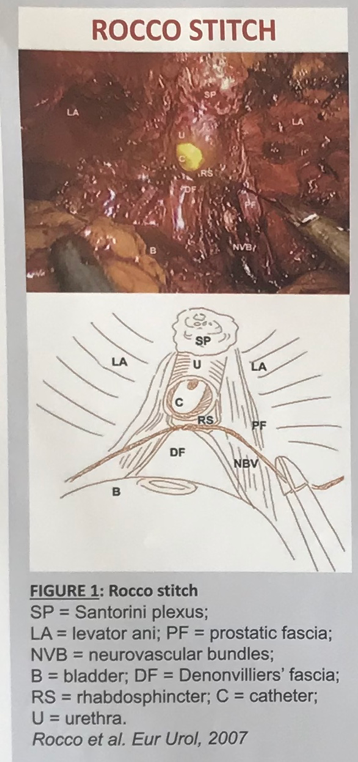In order to investigate this question, a single surgeon was randomized to perform a conventional anastomosis or an anastomosis with the Rocco stitch, pictured below. Patients were blinded to the allocation status and the surgeon was notified immediately prior to the case. Following the surgery, patients completed the Expanded Prostate Cancer Index Composite Short Form (EPIC-26) questionnaire at baseline, 2, 3, 4, 6, 8, and 12-months postoperatively. All data was analyzed in IBM SPSS v25. Continence was defined as 0 pads/day and ≤ 1 pad/day.

Following the completion of the study, 73 patients were enrolled in the interventional, Rocco stitch cohort while 67 patients underwent the control, standard of care procedure. Mean BMI, PSA, and clinical stage were not significantly different. Additionally, there was no significant difference between either of the two cohorts in regard frequency of urine leak, quantity of pad use, and “overall bother” improved significantly in all patients from 2-12 months. Although not statistically significant, 93% of the patients in the experimental, Rocco stitch group stated that they were continent (≤ 1 pad per day) compared to 85.7% in the control group at the 12-month mark.
As she completed her presentation, Dr. Hoogenes explained to the audience that this study was the largest randomized controlled trial of the Rocco stitch technique to date. At the time of presentation, however, the study had not been fully evaluated as there are still data points from the EPIC-26 questionnaire that need to be reviewed as well as other perioperative characteristics.
Presented by: Jen Hoogenes, MSc, PhD
Co-Authors: Derek Bos, Lisa Patterson, Yuding (Ding) Wang, Christopher Wu, Forough Farrokhyar, Bobby Shayegan
Department of Surgery, Division of Urology, McMaster University, Hamilton, ON, Canada
Written by: Zachary Valley, MD, Twitter: @ZacharyAValley, Department of Urology, University of California-Irvine


